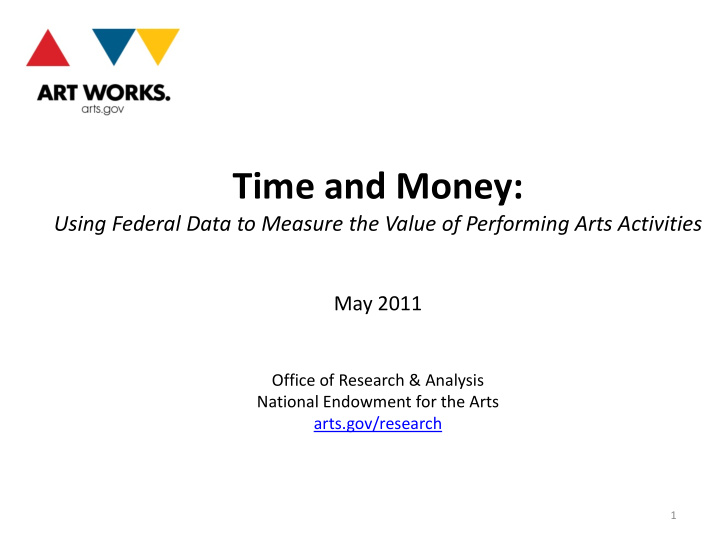



Time and Money: Using Federal Data to Measure the Value of Performing Arts Activities May 2011 Office of Research & Analysis National Endowment for the Arts arts.gov/research 1
Value as Expressed by • Size of Industry, Workforce, Revenue ‐ United States Census Bureau • Consumer Spending ‐ Bureau of Economic Analysis • Consumer Spending ‐ Bureau of Labor Statistics 2
U.S. Performing Arts Industry ( Number of Establishments ) 10,000 7,500 General medical and surgical hospitals Furniture repair Movie theaters 5,000 shops 4,899 2,500 = for ‐ profit Source: U.S. Economic Census, 2007 3
U.S. Performing Arts Industry ( Number of Establishments ) 10,000 Men’s clothing Business, management, stores Life insurance and computer training 8,840 firms schools 7,500 5,000 4,899 2,500 = not ‐ for ‐ profit = for ‐ profit Source: U.S. Economic Census, 2007 4
U.S. Performing Arts Industry ( Number of Paid Workers ) 200,000 150,000 100,000 Computer and office Public relations 54,000 machine repair Cable agencies 50,000 companies = for ‐ profit Source: U.S. Economic Census, 2007 5
U.S. Performing Arts Industry ( Number of Paid Workers ) 200,000 150,000 Ambulance Marketing services consultancies Catering 127,648 100,000 54,000 50,000 = not ‐ for ‐ profit = for ‐ profit Source: U.S. Economic Census, 2007 6
U.S. Performing Arts Industry ( Number of Paid Workers ) Coffee shops 200,000 Oil and gas pipeline construction 183,648 Advertising agencies 150,000 127,648 100,000 54,000 50,000 = for ‐ profit = not ‐ for ‐ profit = self ‐ employed Source: U.S. Economic Census, 2007 7
U.S. Performing Arts Industry ( Total Revenue of Organizations ) $20 bil. $15 bil. Parking lots and Drycleaning and Cafeterias and garages $10 bil. laundry services buffets $8 bil. $5 bil. = for ‐ profit Source: U.S. Economic Census, 2007 8
U.S. Performing Arts Industry ( Total Revenue of Organizations ) $20 bil. Ambulatory surgical and emergency centers $15 bil. HR consulting Direct mail services advertising $13.6 bil. $10 bil. $8 bil. $5 bil. = not ‐ for ‐ profit = for ‐ profit Source: U.S. Economic Census, 2007 9
Not ‐ for ‐ Profit Performing Arts Industry Revenue by Source Earned Income Contributed Income 13% Individuals 21% Total: 46% Foundations 8% $5.6 bil. Business 6% 41% Government 4% Other 2% Other Income Source: 2007 Economic Census, U.S. Census Bureau 10
U.S. Consumer Spending on Admissions Sporting events $20.5 bil. Performing arts $14.5 bil. Car, van, and truck rentals ($11.4 bil.) Moving, storage, and freight delivery ($15.5 bil.) Movie theaters Parking fees and tolls ($15.6 bil.) $10.5 bil. Museums and $6 bil. libraries $5 bil. $9 bil. $13 bil. $17 bil. $21 bil. Source: Bureau of Economic Analysis, U.S. Department of Commerce, 2009 11
Value as Expressed by • Size of Industry, Workforce, Revenue ‐ United States Census Bureau • Consumer Spending ‐ Bureau of Economic Analysis • Consumer Spending ‐ Bureau of Labor Statistics 12
Number of Americans Doing Selected Cultural Activities on an Average Day Movie attendance Sports attendance Arts/crafts activities Other arts and entertainment Performing arts attendance Museum visits 1 mil. 2 mil. 3 mil. 4 mil. Source: American Time Use Survey, 2003 ‐ 2009 13
Number of Americans Doing Selected Cultural Activities on an Average Day Movie attendance Sports attendance Arts/crafts activities 6.5 mil. Other arts and entertainment did at least one activity Performing arts attendance Museum visits 1 mil. 2 mil. 3 mil. 4 mil. Source: American Time Use Survey, 2003 ‐ 2009 14
WHEN DO THEY ATTEND? Percent of those who attend, by time of day 70% 60% 50% 40% 30% 20% 10% 0% 10 AM 11 AM 12 PM 1 PM 2 PM 3 PM 4 PM 5 PM 6 PM 7 PM 8 PM 9 PM 10 PM 11 PM Performing Arts Museums Sports 15 Source: American Time Use Survey, 2003-2009
WHERE DO THEY ATTEND? Performing Arts Attendees “Other” Arts and Entertainment Attendees 10% Places of Worship 9% 36% Schools 8% 64% 65% 8% Outdoors, away from home 4% Bars and restaurants Other 16 Source: American Time Use Survey, 2003-2009
TIME SPENT ON SELECTED CULTURAL ACTIVITIES How long? Time spent on an average day Watching TV and movies 3:18 Sports ‐ going 2:48 “Other” arts and entertainment 2:42 Performing arts attendance 2:36 Arts/crafts 2:30 Museum ‐ going 2:24 Write for personal interest 1:36 Use computer for leisure 1:30 Read for personal interest 1:24 17 Source: American Time Use Survey, 2003-2009
TIME SPENT ON SELECTED CULTURAL ACTIVITIES With whom? Percent of Americans doing the activity with friends Performing arts attendance 41% Sports ‐ going 33% Movie ‐ going 31% Other arts and entertainment 23% Museum ‐ going 19% Arts/crafts 5% Watch TV and movies 5% Use computer for leisure 2% Write for personal interest 1% Read for personal interest <1% 18 Source: American Time Use Survey, 2003-2009
Value as Expressed by • Social Capital ‐ Performing arts attendees are 3.5 times more likely than non ‐ attendees to volunteer in their communities ‐ Regardless of education, gender, or age, performing arts attendance boosts the likelihood of volunteering by 25 percentage points ‐ 1.6 million Americans volunteer primarily or secondarily with arts organizations, and 7.1 million provide “free artistic services” to non ‐ arts groups (Source: Nichols et al ., NEA Research Notes #94 and #95, 2007) 19
Measures of Subjective Well ‐ Being Happiness Surveys
Happiness Surveys • Measures of subjective well ‐ being have recently gained credence (Stiglitz and Sen) • Alan Krueger and the National Institute on Aging (Scale of 0 ‐ 6) 4.3 happiness score for listening to music 2.7 happiness score for doing homework • Special considerations for arts participation
Other Models, Other Measures • Economic Impact Studies (New spending, indirect spending/multipliers) • Contingent Valuation Studies (Willingness to pay) • Hedonic Housing Price Models (Proximity to arts and culture) • Cultural Asset Clusters (Social and economic development)
23
Recommend
More recommend